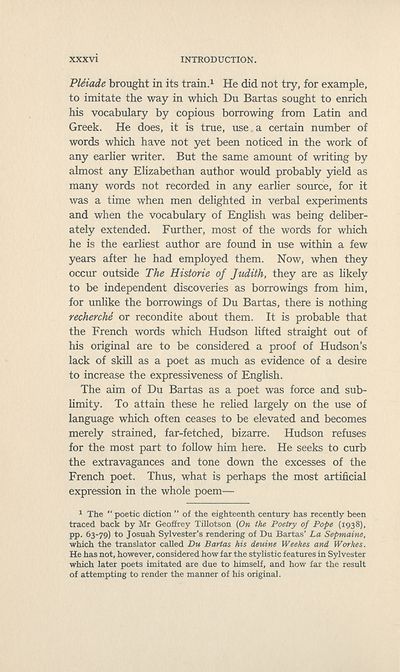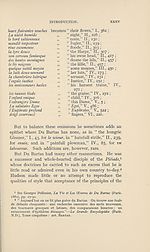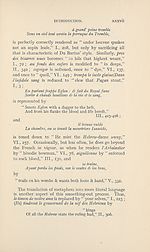Download files
Complete book:
Individual page:
Thumbnail gallery: Grid view | List view

XXXVI
INTRODUCTION.
Pleiade brought in its train.1 He did not try, for example,
to imitate the way in which Du Bartas sought to enrich
his vocabulary by copious borrowing from Latin and
Greek. He does, it is true, use a certain number of
words which have not yet been noticed in the work of
any earlier writer. But the same amount of writing by
almost any Elizabethan author would probably yield as
many words not recorded in any earlier source, for it
was a time when men delighted in verbal experiments
and when the vocabulary of English was being deliber¬
ately extended. Further, most of the words for which
he is the earliest author are found in use within a few
years after he had employed them. Now, when they
occur outside The Histone of Judith, they are as likely
to be independent discoveries as borrowings from him,
for unlike the borrowings of Du Bartas, there is nothing
recherche or recondite about them. It is probable that
the French words which Hudson lifted straight out of
his original are to be considered a proof of Hudson’s
lack of skill as a poet as much as evidence of a desire
to increase the expressiveness of English.
The aim of Du Bartas as a poet was force and sub¬
limity. To attain these he relied largely on the use of
language which often ceases to be elevated and becomes
merely strained, far-fetched, bizarre. Hudson refuses
for the most part to follow him here. He seeks to curb
the extravagances and tone down the excesses of the
French poet. Thus, what is perhaps the most artificial
expression in the whole poem—
1 The “ poetic diction ” of the eighteenth century has recently been
traced back by Mr Geoffrey Tillotson (On the Poetry of Pope (1938),
pp. 63-79) to Josuah Sylvester’s rendering of Du Bartas’ La Sepmaine,
which the translator called Du Bartas his deuine Weekes and Workes.
He has not, however, considered how far the stylistic features in Sylvester
which later poets imitated are due to himself, and how far the result
of attempting to render the manner of his original.
INTRODUCTION.
Pleiade brought in its train.1 He did not try, for example,
to imitate the way in which Du Bartas sought to enrich
his vocabulary by copious borrowing from Latin and
Greek. He does, it is true, use a certain number of
words which have not yet been noticed in the work of
any earlier writer. But the same amount of writing by
almost any Elizabethan author would probably yield as
many words not recorded in any earlier source, for it
was a time when men delighted in verbal experiments
and when the vocabulary of English was being deliber¬
ately extended. Further, most of the words for which
he is the earliest author are found in use within a few
years after he had employed them. Now, when they
occur outside The Histone of Judith, they are as likely
to be independent discoveries as borrowings from him,
for unlike the borrowings of Du Bartas, there is nothing
recherche or recondite about them. It is probable that
the French words which Hudson lifted straight out of
his original are to be considered a proof of Hudson’s
lack of skill as a poet as much as evidence of a desire
to increase the expressiveness of English.
The aim of Du Bartas as a poet was force and sub¬
limity. To attain these he relied largely on the use of
language which often ceases to be elevated and becomes
merely strained, far-fetched, bizarre. Hudson refuses
for the most part to follow him here. He seeks to curb
the extravagances and tone down the excesses of the
French poet. Thus, what is perhaps the most artificial
expression in the whole poem—
1 The “ poetic diction ” of the eighteenth century has recently been
traced back by Mr Geoffrey Tillotson (On the Poetry of Pope (1938),
pp. 63-79) to Josuah Sylvester’s rendering of Du Bartas’ La Sepmaine,
which the translator called Du Bartas his deuine Weekes and Workes.
He has not, however, considered how far the stylistic features in Sylvester
which later poets imitated are due to himself, and how far the result
of attempting to render the manner of his original.
Set display mode to: Large image | Zoom image | Transcription
Images and transcriptions on this page, including medium image downloads, may be used under the Creative Commons Attribution 4.0 International Licence unless otherwise stated. ![]()
| Publications by Scottish clubs > Scottish Text Society publications > Third series > Thomas Hudson's historie of Judith > (42) |
|---|
| Permanent URL | https://digital.nls.uk/106910437 |
|---|
| Description | A collection of over 100 Scottish texts dating from around 1400 to 1700. Most titles are in Scots, and include editions of poetry, drama, and prose by major Scottish writers such as John Barbour, William Dunbar, Gavin Douglas, and George Buchanan. Edited by a key scholarly publisher of Scotland's literary history, and published from the late 19th century onwards by the Scottish Text Society. Available here are STS series 1-3. |
|---|

